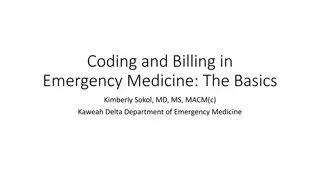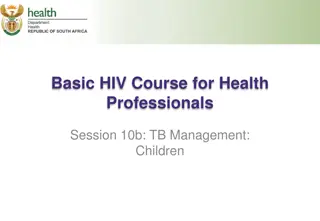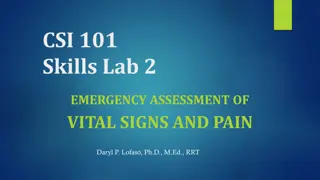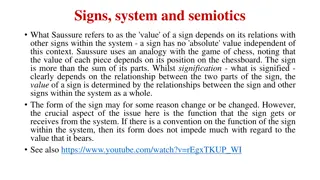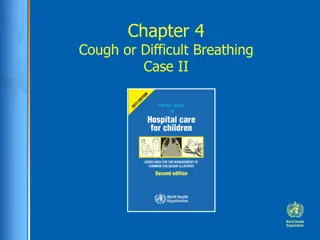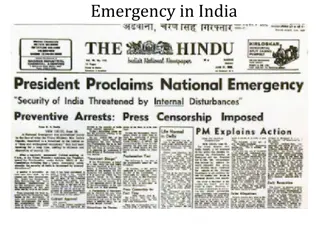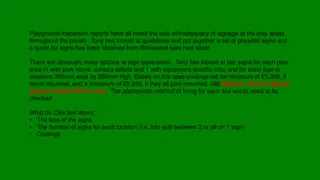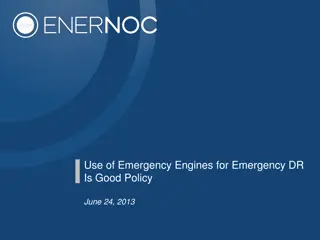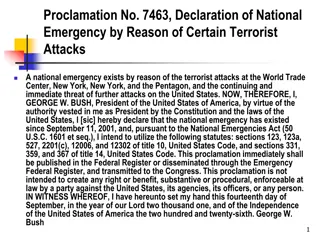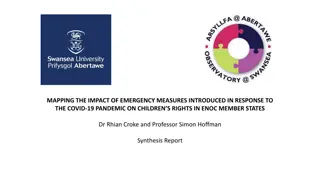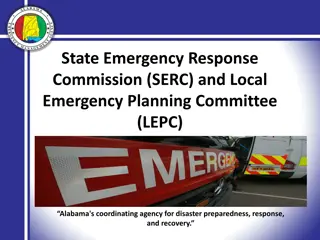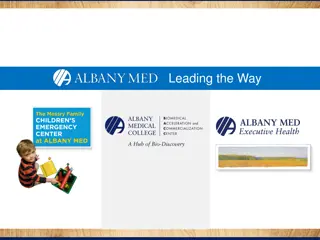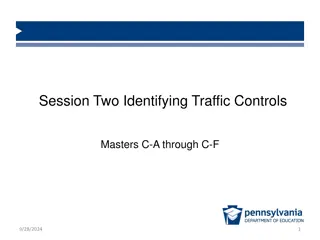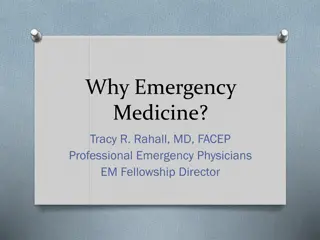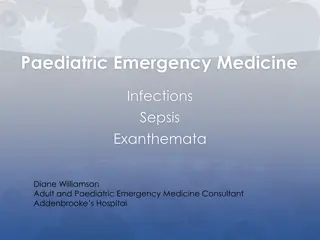National Findings on Children's Vital Signs in Emergency Medicine
This clinical audit by The Royal College of Emergency Medicine in 2015-16 focused on assessing emergency departments' performance against clinical standards related to vital signs in children. The audit objective was to identify current performance levels and facilitate quality improvement. The standards included timely recording of vital signs, recognition of abnormalities, appropriate actions, and follow-up reviews for discharged children with persistently abnormal vital signs. The executive summary graph depicted compliance rates with audit standards, with higher scores indicating better performance. National results showed varying levels of adherence to the standards, emphasizing the importance of consistent monitoring and response to vital signs in pediatric patients.
Download Presentation

Please find below an Image/Link to download the presentation.
The content on the website is provided AS IS for your information and personal use only. It may not be sold, licensed, or shared on other websites without obtaining consent from the author. Download presentation by click this link. If you encounter any issues during the download, it is possible that the publisher has removed the file from their server.
E N D
Presentation Transcript
The Royal College of Emergency Medicine Clinical Audits Vital Signs in Children Clinical Audit 2015-16 National findings The Royal College of Emergency Medicine
Contents This shows how EDs are performing against the audit standards. For further information, please see the national report.
Audit objective Identify current performance in EDs against clinical standards and display the results in order to facilitate quality improvement.
Standards Standard Standard type 1. All children attending the emergency department with a medical illness should have a set of vital signs consisting of Fundamental (a) temperature, respiratory rate, heart rate, oxygen saturation, GCS or AVPU score, and (a) Developmental (b) capillary refill time (b) recorded in the notes within 15 minutes of arrival or triage, whichever is the earliest. 2. Children with any recorded abnormal vital signs should have a further complete set of vital signs recorded in the notes within 60 minutes of the first set. 3. There should be explicit evidence in the ED record that the clinician recognised the abnormal vital signs (if present). Developmental Developmental 4. There should be documented evidence that the abnormal vital signs (if present) were acted upon in all cases. 5. Children with any recorded persistently abnormal vital signs who are subsequently discharged home should have documented evidence of review by a senior doctor (ST4 or above in emergency medicine or paediatrics, or equivalent non-training grade doctor). Fundamental Developmental
Executive summary This graph shows how EDs performed on all standards for this audit. Higher scores (e.g. 100%) indicate higher compliance with the standards and better performance. Standards: Fundamental Developmental
National results (part 1) National Results (16231 cases) Standard RCEM Lower quartile Upper quartile Median STANDARD 1a: All children attending the emergency department with a medical illness should have a set of vital signs consisting of (a) temperature, respiratory rate, heart rate, oxygen saturation, GCS or AVPU score recorded in the notes within 15 minutes of arrival or triage, whichever is the earliest. 100% 25% 37% 52% STANDARD 1b: All children attending the emergency department with a medical illness should have a set of vital signs consisting of (a) temperature, respiratory rate, heart rate, oxygen saturation, GCS or AVPU score, and (b) capillary refill time recorded in the notes within 15 minutes of arrival or triage, whichever is the earliest. 100% 7% 20% 37%
National results (part 2) National Results (16231 cases) Standard RCEM Lower quartile Upper quartile Median STANDARD 2: Children with any recorded abnormal vital signs have a further complete set of vital signs recorded in the notes within 60 minutes of the first set (including CRT). 0% 4% 11% 100% STANDARD 3: Explicit evidence in the ED record that the clinician recognised the abnormal vital signs. 52% 71% 86% 100% STANDARD 4: Documented evidence that the abnormal vital signs (if present) were acted upon in all cases. 55% 74% 89% 100% STANDARD 5: Children with any recorded persistently abnormal vital signs who are subsequently discharged home have documented evidence of review by a senior doctor (ST4 or above in emergency medicine or paediatrics, or equivalent non-training grade doctor). 100% 33% 60% 100%
Casemix How do patients attending EDs compare nationally? This section helps you understand more about the case mix and demographics of the patients.
Patient age Sample: all patients This shows that more than a third of paediatric patients presenting with a medical illness are infants (below 2 years) and therefore the most challenging group to assess.
Grade of doctor first assessing Sample: all patients Nearly half of these patients are first assessed by a more experienced emergency doctor, which is a welcome statistic.
Vital signs scoring system Sample: all patients There is clearly a heterogeneous range of scoring systems being used, and this is an opportunity for improvement. To enable sick children to be identified, there is a clear need to agree a standardised scoring method that all clinicians can use. RCEM recommends PEWS (or an equivalent early warning score), as this will minimise the risk of miscommunication.
Audit results How did EDs perform against the standards? This section helps you understand more about how EDs performed nationally.
Initial vital signs recorded STANDARD 1: All children attending the emergency department with a medical illness should have a set of vital signs consisting of (a) temperature, respiratory rate, heart rate, oxygen saturation, GCS or AVPU score, and (b) capillary refill time recorded in the notes within 15 minutes of arrival or triage, whichever is the earliest. Sample: all patients
Which vital signs were recorded? Sample: all patients While the proportion of children being assessed within 15 minutes could be better, it is gratifying to see that the vast majority are having their vital signs taken and recorded in the notes.
Abnormal vital signs recognised STANDARD 3: There should be explicit evidence in the ED record that the clinician recognised the abnormal vital signs (if present). Subsample: Q6=yes (n=7073) It is important for clinicians to document the patient observations and, where possible, record care plans. A standardised assessment chart might be able to better capture some of this expert practice.
Abnormal vital signs acted on STANDARD 4: There should be documented evidence that the abnormal vital signs (if present) were acted upon in all cases. Subsample: Q6=yes (n=7073) This appears a good result with approximately 75% of patients having action taken. However, lower performing EDs are strongly recommended to investigate and address the reasons.
Repeat vital signs recorded STANDARD 2: Children with any recorded abnormal vital signs should have a further complete set of vital signs recorded in the notes within 60 minutes of the first set. Subsample: Q6=yes (n=7073) Of the 7073 children with abnormal initial observations, 7% had a repeat set of observations recorded within 60 minutes.
Senior review for children discharged with persistently abnormal signs STANDARD 5: Children with any recorded persistently abnormal vital signs who are subsequently discharged home should have documented evidence of review by a senior doctor (ST4 or above in emergency medicine or paediatrics, or equivalent non-training grade doctor). Subsample: Q11=yes and Q6, 10 & 11a=abnormal vital signs
Recommendations 1. ED clinicians should ensure that children presenting with medical illnesses have a full set of vital signs taken and documented within 15 minutes of arrival or triage. 2. ED clinicians should ensure that children with abnormal vital signs should have a further complete set taken and documented within 60 minutes. 3. ED clinicians should ensure adequate documentation of patients care plans for those with abnormal vital signs, ensuring consistent validation and escalation of abnormal results. 4. ED clinicians should consider with management how to maximise consistency of assessment. RCEM recommends that all EDs adopt a vital signs scoring system, such as PEWS (or an equivalent early warning score). 5. review of paediatric patients discharged with abnormal vital signs. ED clinicians should ensure a reliable process for senior
Next steps Read the full report Action planning Rapid cycle quality improvement Contact other EDs for tips & solutions



